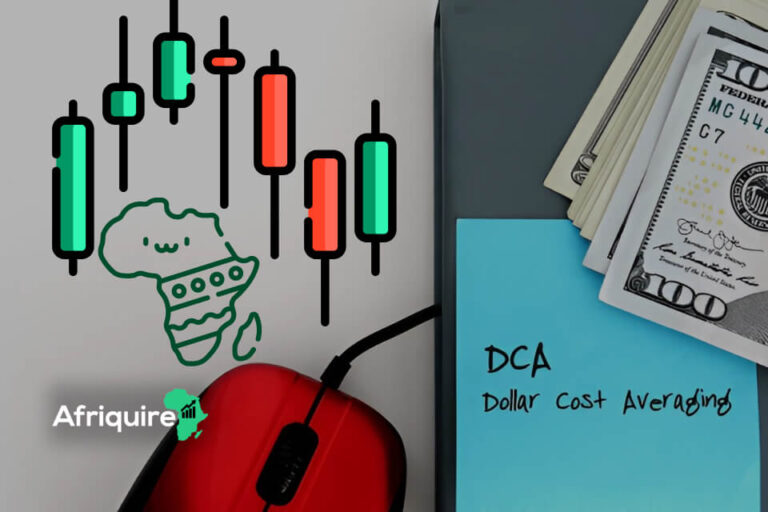Introduction
Building a bond funds investment portfolio is one of the smartest ways to keep money safe and steady, even when the financial markets get shaky. In Africa, where stock prices can rise and fall very quickly, many investors prefer a portfolio that gives both growth and stability. This is where bond funds shine.
Throughout this article, you will see why bond funds matter, understand how they work, and their benefits and risks attached to them.
Why Bond Funds Matter in a Diversified Portfolio
First, let us understand why bond funds are important. In a diversified portfolio, bonds balance out the ups and downs of stocks. Diversification simply means putting your money in different types of investments, so that if one loses value, you do not lose everything at once. Bond funds are great for this because even when stock prices fall, many bonds remain stable or lose less. In fact, bond funds collect money from many investors and spread it across several bonds.
For African investors, this means a safer way to earn steady interest payments without the stress of choosing individual bonds. It also gives instant access to both corporate bonds, which are from companies, and government bonds, which are from the government.This is why most investment apps in Africa include bond funds as part of their options.
Another reason is professional management. Fund managers choose which bonds to buy, check risks, and adjust if a company or government becomes weaker. So, even beginners get support. Today, many African apps and banks provide simple access to bond funds, making them a friendly choice for new and young investors.
Difference Between Stocks and Bonds in Terms of Risk
Now, let us compare stocks and bonds.
Stocks are a share of ownership in a company. When the company does well, stock prices go up. But if things go badly, the prices drop quickly. This makes stocks riskier, but they can also give higher returns in the long run.
Bonds, however, are like loans you give to a company or government. In return, you receive regular interest. At the end of the agreed time, your money is paid back. The main risk is if the borrower, called the issuer, cannot pay back. But with strong governments or trusted companies, this risk is smaller.
In general, government bonds are safer but pay lower interest, while corporate bonds carry higher risk but often give better rewards. A bond fund reduces this risk further because it holds many bonds, so one bad bond will not damage the whole portfolio.
Compared to stocks, bonds do not swing in price every day. This means that when African markets face trouble, a bond funds investment portfolio helps to keep things more stable.
Understanding Bond Funds
A bond funds investment portfolio is one powerful way for African investors to keep money safe, earn steady income, and reduce risks while it still grows. Let’s make it simple as we look at government bond funds vs corporate bond funds, and the main features of African bond funds.
What Are Government Bond Funds?
Government bond funds are groups of bonds that governments issue. These could be Nigerian Federal Government Bonds, South African Rands Bonds, or Kenyan Treasury Bonds. The fund collects money from many investors and then buys plenty of these official bonds. Because governments stand behind them, they are usually very safe. They bring calm and keep your money steady during tough times.
In fact, government bond funds usually pay fixed interest. This means you already know how much you will get monthly, which makes planning much easier.
Also, professional fund managers handle them. They pick and track bonds to make sure risks are low and income remains stable. The good part is that you don’t need to buy government bonds by yourself. Instead, through one fund, you get exposure to a wide basket of safe bonds. That is why, whenever you compare stock and bond investment apps, you will always see government bonds holding their place as the foundation of a balanced portfolio.
What Are Corporate Bond Funds?
Corporate bond funds, on the other hand, are bonds issued by companies. These could be from big African banks, telecom companies, or global brands working in Africa. Unlike government bonds, corporate bonds usually pay higher interest. However, they also come with more risk because companies might struggle to pay their loans back.
Nevertheless, professional managers check the financial strength and credit ratings of companies before adding their bonds into the fund. If you compare corporate bonds with government bonds, you will notice corporate bonds can give higher returns but with more risk.
That is why a smart bond portfolio mixes both. You get stable returns from government bonds and higher potential income from corporate bonds. And yes, stock and bond investment apps make it easy to track this mix and even switch when the market changes.
Key Features of African Bond Funds
African bond funds have their own special features.
First, they allow investors to diversify, reduce risk, and earn income, even with small amounts of money. Buying individual bonds directly may need a lot of cash, but bond funds allow you to invest less and still enjoy professional management.
Moreover, fund managers in Africa carefully watch risks like currency changes, political events, and inflation, so your portfolio can stay safe.
Many African bond funds also mix both government and corporate bonds, and sometimes even high-yield bonds (called “junk bonds”).
High-rated bonds are safer but pay less, while low-rated bonds pay more but come with higher risk. So, as experts advise, always check the fund’s mix, credit rating, maturity, and management style before investing.
In addition, African bond funds usually pay monthly income, so you get regular cash. They are also flexible, meaning you can sell your shares anytime.
With Africa’s growing investment market, stock and bond apps now make it easy to monitor balance, compare bonds, and check returns right on your phone.

Benefits of Adding Bonds to a Portfolio
One of the smartest ways to build a strong and steady investment portfolio is by adding bond funds into your portfolio. A bond fund investment gives you several benefits that can help create stability, reduce risk, and bring more balance to your investments.
Stability Through Fixed-Income Returns
One big reason why many investors like bond funds is because of the stability they bring through fixed income. When you buy a bond fund, you are basically lending your money to either a government or a company. In return, they pay you back with regular interest, which people also call coupons. These payments give you a steady income, unlike stocks that can move up and down suddenly.
This steady flow of money makes bond funds a reliable choice, especially if you don’t like the roller-coaster ride of the stock market. And at the end of the loan period, you usually get back the money you first invested. This makes bonds even more secure for people who want peace of mind.
Lower Volatility Compared to Stocks
Stocks can be exciting, but they are also very unpredictable. The prices can jump up or crash down quickly because of company news, changes in the economy, or global events. On the other hand, bond funds normally do not swing so much in price. This lower volatility means that your portfolio is safer during hard times or sudden market drops.
It is also useful to understand the difference between corporate bonds and government bonds. Corporate bonds, which are from companies, usually pay higher returns but also carry a bit more risk. Government bonds are safer because governments are more trusted to pay back, but the returns are lower. Having a mix of both corporate and government bonds in your portfolio helps you balance risk and reward in a way that suits you.
Diversification Across Asset Classes
Diversification means spreading your money across different types of investments so that you don’t depend only on one. With bond funds, you are not putting all your eggs in one basket. They often contain many bonds from different industries, issuers, and even countries. This makes it less risky, because if one bond does badly, the others can cover it.
Even more, when you combine bond funds with stocks, your portfolio becomes stronger. Stocks bring growth, while bonds provide income and stability. Many investors today use stock and bond investment apps to make this easier. These apps allow you to quickly adjust the mix between stocks and bonds depending on changes in your life or in the market.
Case Study: African Bond Opportunities
African countries are increasingly issuing bonds in international markets, creating new chances for investors to earn returns on stable debt instruments. These offer higher yields compared to bonds from developed countries and can add diversity to an investment portfolio.
Côte d’Ivoire Eurobonds Yield Performance
Côte d’Ivoire is one of the top African countries that sells eurobonds. The bonds they offer usually pay higher interest than many Western government bonds.
For example, some recent Côte d’Ivoire eurobonds paid about 6 to 7 percent. This is much higher than what you may find in Europe or America. The reason is simple—investors are paid more because of the extra risks that come with investing in emerging markets.
Comparing Yields Across African Markets
Yields, or the amount of interest bonds pay, are not the same everywhere. They depend on how strong a country’s economy is, its credit rating, and how much investors trust it. For example, South Africa often pays lower yields because its credit rating is stronger. On the other hand, Nigeria may pay higher yields, but with more political and economic risks. Kenya also offers good opportunities.
By putting money into a bond fund that covers different African countries, investors can enjoy higher income but also reduce the risk of losing money.
Risks and Rewards of Emerging Market Bonds
Now, every investment has both rewards and risks. For African bonds, the rewards are clear – you can earn more income and also diversify, which means not depending only on Western markets. This helps protect your portfolio when other assets, like stocks, are not doing well.
But, there are risks too. Since many bonds are in dollars or euros, changes in exchange rates can affect how much you really earn. Also, political problems in some countries can affect repayments. Finally, global interest rate changes can cause bond prices to rise or fall.

Strategies for Using Bond Funds in Portfolios
Using bond funds in a portfolio is a smart way to build stability and balance. For many African investors, who want steady returns without too much risk, a bond funds investment portfolio is a good option. It gives you a way to grow money while keeping it safer compared to only investing in stocks. Here’s a simple guide on how you can use bond funds wisely for better financial growth.
Balancing Bonds and Equities
First, one important strategy is balancing bonds and equities in your portfolio. Stocks, also called equities, usually bring higher returns but they can also go up and down quickly, which makes them risky. On the other hand, bonds provide more steady income with lower risk. So, when you combine them, you create a balance.
Imagine it like this: if your stocks are like a fast-moving vehicle, then your bonds are like a calm boat on the water. When stocks fall, bonds can help reduce the damage. This way, your portfolio benefits from growth while also protecting you against big losses. By mixing government bonds and corporate bonds through bond funds, you enjoy both safety and opportunity.
Choosing Between Short-Term and Long-Term Bonds
Another key point is deciding between short-term and long-term bonds when investing in bond funds.
Short-term bonds normally mature in a few years. They are less sensitive to interest rate changes, so they are safer, but their returns may be smaller.
Long-term bonds, however, last many years. They pay more interest, but if interest rates rise, their value can drop.
Therefore, you need to think about your goals and how much risk you want. If you prefer stability now, short-term bonds are better. But if you are looking for more income over a long period, then long-term bonds may be the right choice. Many investors use a mix of both to spread the risk and still enjoy steady growth.
Reinvesting Returns for Compounding Growth
A very useful tactic is reinvesting the returns you get from bond funds. Bond funds usually pay interest, also called coupons, at regular times. You can either take this money out as income or reinvest it back into the fund to buy more units.
Reinvesting allows your money to grow through compounding, which means you start earning returns on your past returns.
Over time, this can make a huge difference. Even if you begin with a small investment, compounding helps it grow bigger each year. This is one of the simplest but most powerful ways to build wealth with bond funds.
Managing Risks in Bond Investments
Just like every other investment, bond funds have their own risks. To do well, you must understand these risks and also learn how to manage them properly. This guide will explain the main risks and show how diversification in African bond funds can protect your money.
Interest Rate and Inflation Risks
One of the biggest risks in bond funds is interest rate risk. This simply means that when interest rates go up, the value of bonds usually goes down. Why? Because new bonds now pay higher rates, and that makes older bonds with lower rates less attractive. If you want to sell your bond before it finishes (maturity), you may lose money if interest rates have risen.
Another big risk is inflation. Inflation means that the prices of goods and services keep increasing. If your bond pays you a fixed interest, but inflation goes up faster, then the money you earn will not buy as much as before. For example, if your bond pays 8% interest but inflation is 10%, then your real return is actually lower. This is why it is important to always think about both interest rates and inflation when you build your bond funds portfolio.
Credit Risks in Government vs Corporate Bonds
Another type of risk is called credit risk. This is the chance that the person or organisation that issued the bond cannot pay back the money or interest as promised.
Government bonds are usually safer, especially from stable countries, because the government backs them. But in some African countries, government bonds can still carry higher risks if the economy is unstable.
Corporate bonds are different. These bonds are issued by companies, and they usually pay higher interest rates because companies can face more problems during tough times.
For example, if a company is not making profit, it might struggle to pay investors. So corporate bonds can give better returns, but they are also riskier than government bonds. The decision between the two depends on your goals and how much risk you can handle.
Diversification Within African Bond Funds
The secret to protecting yourself in bond investing is diversification. Diversification means not putting all your eggs in one basket. Instead, you spread your money across different bonds, countries, and companies. African bond funds often include both government and corporate bonds from many nations. This way, if one issuer fails, the effect on your total portfolio is smaller.
Another smart way to diversify is by mixing bonds of different lengths, called maturities. Short-term bonds are less risky when interest rates rise, while long-term bonds often pay more interest but their prices move up and down more. By diversifying across maturities, you can balance risk and income better.
Today, many investment apps allow you to invest in African bond funds easily. These apps make it simple to monitor and manage your money, even if you are just starting out as a beginner.

Measuring Portfolio Impact
Bond funds are less risky than shares, so many people use them when they want stability. But after investing, how do you check if your bond portfolio is working well for you? The answer is by learning how to track performance, test stability, and make adjustments as time goes on.
Tracking Performance Against Benchmarks
The first step is checking your bond portfolio against benchmarks. Think of benchmarks like scoreboards. They show you how your bond fund is doing compared to others. For example, if your fund invests in government bonds, you can compare it with a government bond index. If it invests in company bonds, then you check against a corporate bond index. These comparisons help you know if your fund is performing as expected or if you should make changes.
Today, many investment apps make this easier. You can simply check your phone and see if your bond portfolio is on track. This is very useful for African investors who want to stay updated without stress.
Evaluating Stability and Income Flow
Another reason people love bond funds is because of the stability and regular income. Unlike shares, which can rise or fall sharply, bonds usually give you steady interest payments. This makes them useful for people who need to plan ahead for things like school fees, rent, or family costs.
To measure impact, you should check how consistent the income payments are and how stable the fund’s value stays over time. Funds that remain steady bring trust, because they help you plan with confidence. However, remember that not all bonds are the same. Government bonds are usually safer but pay less, while corporate bonds pay more but carry more risk. Understanding this difference is very important when you are judging your portfolio.
Adjusting Allocation Over Time
Finally, you should not just invest in a bond portfolio and forget it. Markets change, interest rates go up and down, and your personal goals also shift. Because of this, it is important to review and adjust your investments from time to time.
For instance, when interest rates rise, old bonds may lose value. In that case, you may want to move into shorter-duration bonds or explore different bond sectors. Many investors use stock and bond apps to monitor their portfolio and rebalance when needed. This helps you remain in control and make smart choices that match your financial goals.
Frequently Asked Questions (FAQs)
1. What is a bond funds investment portfolio?
A bond funds investment portfolio is a collection of bond investments managed together. It usually includes government and corporate bonds to provide steady returns and reduce risk.
2. How do bond funds provide stability?
Bond funds offer regular income through interest payments and are less risky compared to stocks, which helps stabilize your overall investment portfolio especially during market ups and downs.
3. Can I buy a bond fund easily? Yes, you can invest in bond funds through stock and bond investment apps, making it simple and convenient to add bonds to your portfolio.
4. What is the difference between corporate bonds and government bonds?
Corporate bonds are loans to companies and usually pay higher interest due to higher risk. Government bonds are loans to the government and are generally safer.
5. Are bond funds suitable for beginners?
Yes, bond funds are a good option for beginners because they offer diversification and are managed by professionals.
Conclusion
A bond fund investment portfolio is a smart way to make your money more stable. First, by having both government bonds and company bonds, these funds reduce the risk of losing money while giving you regular income. Also, thanks to stock and bond investment apps, putting money into bonds is now simple and easy for anyone. Of course, bond prices can change when interest rates move, but a well-diversified bond fund balances these risks and possible profits.
Moreover, understanding how bond funds fit into your investment plan helps you manage your money wisely. Therefore, thinking about the different types of bonds and how they bring stability can help you make better financial choices. In short, using a bond fund portfolio could be the key to steady and safe growth for your investments.



